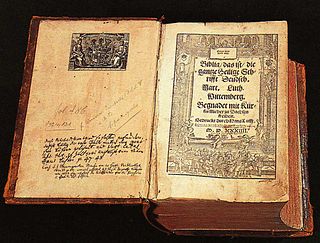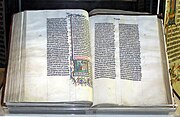
The Bible is a collection of religious texts or scriptures, some, all, or a variant of which, are held to be sacred in Christianity, Judaism, Samaritanism, Islam, Baha'i'ism and many other religions. The Bible is an anthology, a compilation of texts of a variety of forms, originally written in Hebrew, Aramaic, and Koine Greek. These texts include instructions, stories, poetry, and prophecies, and other genres. The collection of materials that are accepted as part of the Bible by a particular religious tradition or community is called a biblical canon. Believers in the Bible generally consider it to be a product of divine inspiration, but the way they understand what that means and interpret the text varies.

The Book of Nehemiah in the Hebrew Bible, largely takes the form of a first-person memoir by Nehemiah, a Jew who is a high official at the Persian court, concerning the rebuilding of the walls of Jerusalem after the Babylonian exile and the dedication of the city and its people to God's laws (Torah).
The deuterocanonical books are books and passages considered by the Catholic Church, the Eastern Orthodox Church, the Oriental Orthodox Churches, and/or the Assyrian Church of the East to be canonical books of the Old Testament, but which Jews and Protestants regard as apocrypha. They date from 300 BC to 100 AD, before the separation of the Christian church from Judaism. While the New Testament never directly quotes from or names these books, the apostles quoted the Septuagint, which includes them. Some say there is a correspondence of thought, and others see texts from these books being paraphrased, referred, or alluded to many times in the New Testament, depending in large measure on what is counted as a reference.
The Old Testament (OT) is the first division of the Christian biblical canon, which is based primarily upon the 24 books of the Hebrew Bible, or Tanakh, a collection of ancient religious Hebrew and occasionally Aramaic writings by the Israelites. The second division of Christian Bibles is the New Testament, written in the Koine Greek language.

The Hebrew Bible or Tanakh, also known in Hebrew as Miqra, is the canonical collection of Hebrew scriptures, including the Torah, the Nevi'im, and the Ketuvim. Different branches of Judaism and Samaritanism have maintained different versions of the canon, including the 3rd-century BCE Septuagint text used in Second Temple Judaism, the Syriac Peshitta, the Samaritan Pentateuch, the Dead Sea Scrolls, and most recently the 10th-century medieval Masoretic Text compiled by the Masoretes, currently used in Rabbinic Judaism. The terms "Hebrew Bible" or "Hebrew Canon" are frequently confused with the Masoretic Text; however, this is a medieval version and one of several texts considered authoritative by different types of Judaism throughout history. The current edition of the Masoretic Text is mostly in Biblical Hebrew, with a few passages in Biblical Aramaic.
The Ketuvim is the third and final section of the Tanakh, after Torah ("instruction") and Nevi'im ("prophets"). In English translations of the Hebrew Bible, this section is usually titled "Writings" or "Hagiographa".

The Aleppo Codex is a medieval bound manuscript of the Hebrew Bible. The codex was written in the city of Tiberias in the tenth century CE under the rule of the Abbasid Caliphate, and was endorsed for its accuracy by Maimonides. Together with the Leningrad Codex, it contains the Ben-Asher masoretic tradition.
1 Esdras, also Esdras A, Greek Esdras, Greek Ezra, or 3 Esdras, is the ancient Greek Septuagint version of the biblical Book of Ezra in use within the early church, and among many modern Christians with varying degrees of canonicity. 1 Esdras is substantially similar to the standard Hebrew version of Ezra–Nehemiah, with the passages specific to the career of Nehemiah removed or re-attributed to Ezra, and some additional material.

The Leningrad Codex is the oldest complete manuscript of the Hebrew Bible in Hebrew, using the Masoretic Text and Tiberian vocalization. According to its colophon, it was made in Cairo in AD 1008.
The name "Esdras" is found in the title of four texts attributed to, or associated with, the prophet Ezra. The naming convention of the four books of Esdras differs between church traditions; and has changed over time.
The prophetic books are a division of the Christian Bible, grouping 18 books or 17 books in the Old Testament. In terms of the Tanakh, it includes the Latter Prophets from the Nevi'im, with the addition of Lamentions and Daniel, both of which are included among the books of the Hebrew Ketuvim.
The Old Testament is the first section of the two-part Christian biblical canon; the second section is the New Testament. The Old Testament includes the books of the Hebrew Bible (Tanakh) or protocanon, and in various Christian denominations also includes deuterocanonical books. Orthodox Christians, Catholics and Protestants use different canons, which differ with respect to the texts that are included in the Old Testament.
There is no scholarly consensus as to when the Hebrew Bible canon was fixed. Some scholars argue that it was fixed by the Hasmonean dynasty, while others argue it was not fixed until the second century CE or even later.
Biblical languages are any of the languages employed in the original writings of the Bible. Partially owing to the significance of the Bible in society, Biblical languages are studied more widely than many other dead languages. Furthermore, some debates exist as to which language is the original language of a particular passage, and about whether a term has been properly translated from an ancient language into modern editions of the Bible. Scholars generally recognize three languages as original biblical languages: Hebrew, Aramaic, and Koine Greek.
Melito's canon is the biblical canon attributed to Melito of Sardis, one of the early Church Fathers of the 2nd century.
A biblical canon is a set of texts which a particular Jewish or Christian religious community regards as part of the Bible.

A Protestant Bible is a Christian Bible whose translation or revision was produced by Protestant Christians. Typically translated into a vernacular language, such Bibles comprise 39 books of the Old Testament and 27 books of the New Testament, for a total of 66 books. Some Protestants use Bibles which also include 14 additional books in a section known as the Apocrypha bringing the total to 80 books. This is in contrast with the 73 books of the Catholic Bible, which includes seven deuterocanonical books as a part of the Old Testament. The division between protocanonical and deuterocanonical books is not accepted by all Protestants who simply view books as being canonical or not and therefore classify books found in the Deuterocanon, along with other books, as part of the Apocrypha. Sometimes the term "Protestant Bible" is simply used as a shorthand for a bible which contains only the 66 books of the Old and New Testaments.

The Orthodox Tewahedo biblical canon is a version of the Christian Bible used in the two Oriental Orthodox Churches of the Ethiopian and Eritrean traditions: the Ethiopian Orthodox Tewahedo Church and the Eritrean Orthodox Tewahedo Church. At 81 books, it is the largest and most diverse biblical canon in traditional Christendom.
The following outline is provided as an overview of and topical guide to the Bible:
The Prologus Galaetus or Galeatum principium is a preface by Jerome, dated 391–392, to his translation of the Liber Regum.







